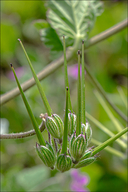|
|
click photo for larger file

Erodium malacoides
Mediterranean Stork's Bill
|
Photographer: Dr. Amadej Trnkoczy
ID: 0000 0000 0723 0102 (2023-07-04)Copyright © 2023 Dr. Amadej Trnkoczy
|
|
INFORMATION PROVIDED WITH THE PHOTO
|
date of photo Apr 17, 2023
latitude 44.52653 longitude 14.48171
View on Google Maps.
location
Adriatic Sea region, island Lošinj, Valdarke beach east of the town Mali Lošinj, Kvarner bay (Rijeka region, Croatia)notes Slo.: srčasto listni čapljevec - syn.: Geranium malacoides L., Erodium althaeoides Jord., Erodium malvaceum Jord., Erodium subtrilobum Jord. - Habitat: grassland patches near sea shore; semiruderal place: locally almost flat terrain; calcareous ground; open, sunny place; precipitations ~ 1.000 mm/year, average temperature 13-14 deg C, elevations 10 m (33 feet), Sub-Mediterranean phytogeographical region. - Substratum: soil. - Comments (pertain to pictures in Flicker album Erodium malacoides): Erodium malacoides is originally a South European, North African and west Asia species, but it is now introduced to all continents of the globe (Ref. 5). The name of the genus comes from the Greek word 'Erodios' meaning a heron suggesting the similarity of the long neck of the heron with the long beak of the fruit of Erodium malacoides. Although the flowers are small, the beak can be as much as 3.5 cm long. 'Malacoides' derives from Greek word 'malakos' meaning soft referring to the leaves. The seeds of the plant are marvelously designed (Fig. 7). They can drill themselves into the ground. To hide themselves from hot, dry soil surface in the Mediterranean late spring and summer conditions is essential for seeds, when they germinate. The case of a seed (mericarp) of the Erodium malacoides (and other Geraniaceae) is narrowly cone shaped, so it can easily find a crack in the soil and protrude in it. It is covered by stiff hairs, which all are oriented at an optimal angle so they exert little friction during driving into the soil, but prevent pulling the seed out of the ground, when it is in place. The driving force resides in the long, coil shaped (when dry), 'tail' (part of the former beak) of the mericarp. The coil starts to unwind itself under the influence of the humidity and hence drives the mericarp with the seed into v soil. The coil has at the other end a long 'lever', which randomly sticks to some ground surface obstacle and hence allows that all rotational moment of the unwinding coil is effected at the tip of the seed case. A perfectly designed 'drilling machine', which is automatically activated when the soil becomes softer (due to moist, rain) (Fig.7). Do you really need a more spectacular miracle? - Ref.: (1) A. Martinči et all., Mala Flora Slovenije (Flora of Slovenia - Key) (in Slovenian), Tehnična Založba Slovenije (2007), p 352. (2) W.K. Rottensteiner, Exkursionsflora für Istrien, Verlag des Naturwissenschaftlichen Vereins Kärten (2014), p 517. (3) T. Nikolić, Flora Croatica, Vaskularna flora Republike Hrvatske, Vol. 3. Alfa d.d.. Zagreb (2020) p 27, (4) M. Blamey, C. Grey-Wilson, Wild Flowers of the Mediterranean, A & C Black, London (2005), p 113. (5) https://powo.science.kew.org/taxon/urn:lsid:ipni.org:names:372332-1 (accessed: July 2. 2023)camera Sony ILCE6000 / Carl Zeiss Vario-Tessar E 16-70 mm/f4
contributor's ID # Bot_1515/2023_DSC2566 photo category: Plant - annual/perennial
|
MORE INFORMATION ABOUT THIS PLANT
|
| common names
Mediterranean Stork's Bill, Soft Stork's-bill (photographer)
View all photos in CalPhotos of Erodium malacoides Check Google Images for Erodium malacoides |
|
The photographer's identification Erodium malacoides has not been reviewed. Click here to review or comment on the identification. |
|
Using this photo The thumbnail photo (128x192 pixels) on this page may be freely used for personal or academic purposes without prior permission under the Fair Use provisions of US copyright law as long as the photo is clearly credited with © 2023 Dr. Amadej Trnkoczy.
For other uses, or if you have questions, contact Dr. Amadej Trnkoczy amadej.trnkoczy[AT]siol.net. (Replace the [AT] with the @ symbol before sending an email.) |
|
|
